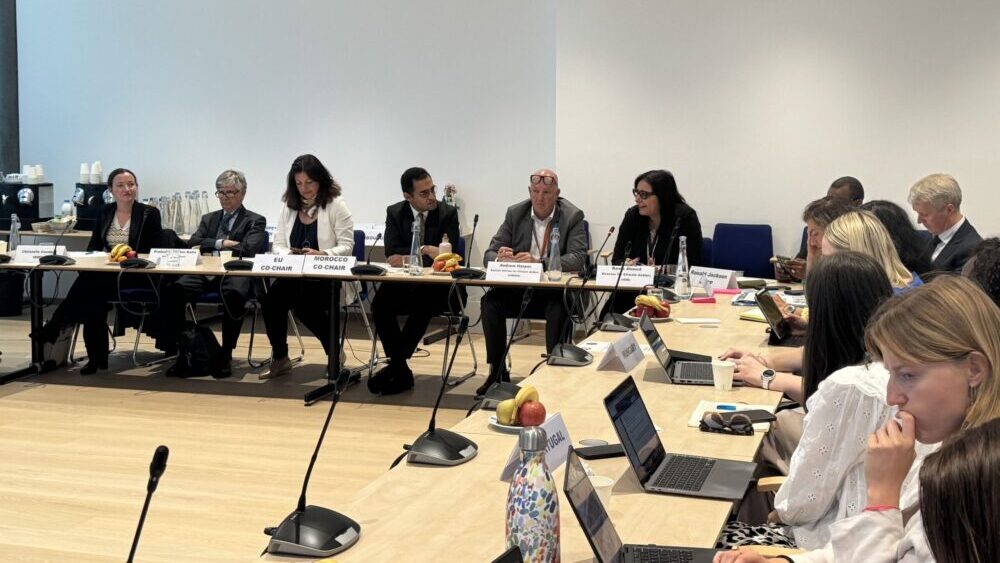Reporting Back | Disaster Displacement at the European Forum for Disaster Risk Reduction

The European Forum for Disaster Risk Reduction took place from 24-26 November. Under the title “Working Together to Reduce Disaster Risks” it brought together State representatives from 49 countries in Europe and Central Asia.
Side Event: Putting Words into Action – Addressing Disaster Displacement in DRR Strategies and Practice
The programme included the official side event “Putting Words into Action – Addressing disaster displacement in DRR strategies and practice”. The event drew together a range of different perspectives and experiences relating to disaster displacement in disaster risk reduction (DRR) strategies and practice. The speakers came from different countries and regions and included representatives from donor governments, civil society organizations, INGOs and NGOs, humanitarian aid agencies, the UN, and think tanks. Throughout the event, the audience heard about the challenges relating to gaps in displacement data that can inform policies and strategies, the need to integrate provisions—backed by data—to address disaster displacement into national and subnational policies and strategies, and the need to build and strengthen capacity at all levels of action, including at the local level.
“It is easier to reduce the risk of displacement, than to support displaced people to build back their lives after a disaster” said Mr. Ara Nazinyan from the United Nations Office for Disaster Risk Reduction (UNDRR) for Europe and Central Asia.
The EU and Global Network of Civil Society Organisations for Disaster Reduction (GNDR) provided insightful introductory remarks, stressing the need for a coherent, integrated approach to addressing disaster displacement in DRR strategies and practice, and the importance of local participation in building long-term resilience to disasters.
“We need a 360-degree approach to address disaster displacement, to prevent and anticipate it, to help people on the move and to strengthen the resilience of displaced people,” declared Ms. Joanna Darmanin from the Directorate-General for European Civil Protection and Humanitarian Aid Operations (DG ECHO) in her presentation.
Attendees then learned from the Internal Displacement Monitoring Centre (IDMC) about how data can better inform policies and strategies, and the German Red Cross presented a reflection on their ongoing response following the summer floods in Germany in 2021, highlighting the need for effective preparedness and planning, and for considering the longer-term impacts of disasters beyond the immediate aftermath.
Representatives from UNDRR and the Norwegian Refugee Council (NRC) shared examples of the policies and tools available to support better integration of displacement considerations into DRR strategies and practice. The tools include, for example, the UNDRR Words into Action (WiA) Guidelines on Disaster Displacement, and accompanying checklist (in English and Spanish) and eLearning, which have already been used by governments and regional bodies around the world to support better integration of disaster displacement into DRR strategies and practice. The Resilience Development Initiative (RDI), for example, described how the WiA tools were used in the Making Displacement Safer project to support people displaced by floods in several Indonesian communities. RDI also highlighted the need to engage displaced people in disaster preparedness and response to adequately address their needs. NRC Mozambique continued on this theme, explaining how the WiA tools had been used to develop the Mozambique Policy and Strategy for Internal Displacement Management. To conclude the event, the German Federal Foreign Office invited other States and stakeholders to use the WiA tools to address displacement in all regions, including Europe.
The side event was organized by NRC and GNDR, with contributions from the PDD, IDMC, the International Federation of Red Cross and Red Crescent Societies, the International Organization for Migration, RDI, the Office of the United Nations High Commissioner for Refugees, and with support from the European Union, France, Germany, Norway and Switzerland.
Outcomes of the European Forum for Disaster Risk Reduction
At the European Forum for Disaster Risk Reduction (EFDRR), governments participated in a Ministerial Roundtable where they endorsed the EFDRR Roadmap 2021-2030. The Roadmap highlights four key areas of work, including understanding and communicating risks, inclusive and collaborative governance and decision-making, supporting resilience, and preparedness. The Roadmap contains a number of references to the need to address displacement, particularly in terms of gathering data and enhancing understanding on displacement-related risks, and the meaningful and inclusive participation of displaced communities in planning and decision-making.
Ministers also signed the Prevention Pledge, which commits “to making disaster prevention and resilience a priority and accelerating the implementation of the Sendai Framework for Disaster Risk Reduction 2015-2030 according to the EFDRR Roadmap 2021-2030”, as well as listing five more specific commitments. A brief overview of the outcomes of the EFDRR is also available via the Chair’s Summary.
Header photo © UNDRR
Read the PDD’s Policy Brief and Key Messages
